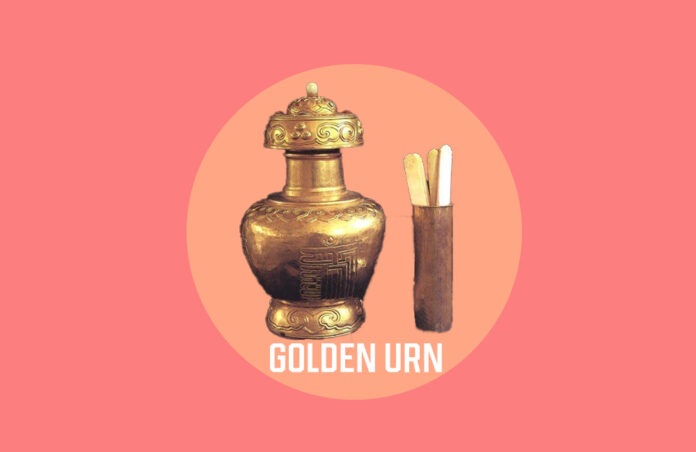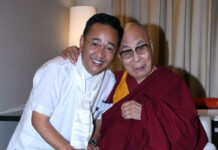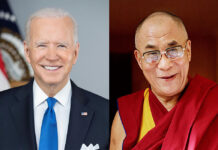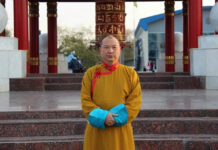Thupten Namgyal* contends that the Golden Urn, though possibly used or claimed to have been used to appease China, did not at all determine the outcome of the selection of the 10th, 11th and 12th Dalai Lamas as Sikyong Penpa Tsering’s remarks to the Russian news Agency Sputnik appeared to suggest.
(TibetanReview.net, Jun29’21)
Upon reading the interview given by the current Sikyong of our exile Tibetan administration to the Russian news media channel Sputnik on 5th July 2021, some of his answers might have caused a little discomfort to many of our Tibetan brothers and sisters. I felt the same, particularly the part where his interpretations of our history of the Tenth, eleventh and the twelfth Dalai Lama reincarnations seemed to be on the wrong side.
To quote his answer, “It was only from the ninth Dalai Lama onwards that the Chinese (rulers) started to get involved in the selection process. So, the 10th, 11th, and the 12th Dalai Lama were chosen through the “Golden Urn” (a method introduced by the Qing Dynasty in the 18th century for the appointment of lamas and other religious leaders).”
History as a subject and discipline has always been my interest and fortunately my further studies have also been on history. With my keen interest in this subject, I had the honour to read about the history of the Dalai Lama and its institution and considering my familiarity with the topic, I must confess that I have never read in any paper or book anything that supports the Sikyong’s statement.
It is true that the Manchus were desperately trying to have a say in the selection process of the Dalai Lama’s reincarnation since the time of the 9th Dalai Lama with the introduction of the so-called ‘Golden Urn’ system of selection. There was definitely the pressure steaming from the Manchus; but our ancestors never kowtowed to their pressure. Nor did the Golden Urn have such major influences as to change the fate of the selection, except in the case of the eleventh Dalai Lama, even in which case the history is far from clear.
My understanding is that it is due to the shortness of their reigns as Dalai lamas which might have opened the door for such interpretations and distortion of history that we are witnessing to this day. These three young Dalai Lamas passed away too young – the tenth Dalai Lama passed away at the age of twenty-one due to poor health, and as regards the eleventh, he died at the age of seventeen, while the twelfth Dalai Lama also passed away in his teens, at the age of nineteenth. The shortness of reign as the leader of the land resulted in little literature and records about them, which might have contributed to this distorted claim.
To disprove the statement made by our Sikyong Penpa Tsering la, I must revisit our history to unlearn his mistakes.
The Tenth Dalai Lama Tsultrim Gyatso
The 10th Dalai Lama was selected from five candidates; two from Tsang and the other three from Kham. Centuries-old Traditional ritual and tests unique to Tibetan Buddhism for the selection process were followed and the boy from Lithang was duly chosen as the 10th Dalai Lama. And he was given the new monastic name Tsultrim Gyatso. The Manchu tried to pressure the Tibetans to use the Golden Urn method; but with the help of three representatives from the three big monasteries, along with the Kashag and regent, they discreetly conducted the tests and chose the Lithang boy as the next Dalai Lama. The Golden Urn was not used to decide the selection’s fate. But in order to appease the Chinese amban, the Tibetans claimed to have used the Golden Urn.
In Tsepon Shakabpa’s One Hundred Thousand Moons: An Advanced Political History of Tibet, it is clearly written: “Thus, on the fifteenth day of the first month, the regent announced that the candidate from Shokdruk Drodong Tsang in Litang had been confirmed by the golden urn lottery. This calmed the feelings of the people of Tibet, like pouring cold water into boiling milk. In fact, however, the golden urn lottery had not been used. The pretense of having employed it seems to have satisfied the ambans. In dependence on the false announcement, it is even reported in biographies.”
This finds support in Alexander Norman’s The Secret Lives of the Dalai Lama: Holder of the White Lotus, one of the most detailed book ever written on the history of Dalai Lama and its institution, where it is written; “The Lithang candidate would be officially confirmed in the office without recourse to the golden urn but, for the form’s sake, they would give out that it had in fact been used.”
Also it is written on the official website of His Holiness the 14th Dalai Lama: “Even in the case of the Tenth Dalai Lama, the authentic reincarnation had already been found and in reality this procedure was not followed, but in order to humour the Manchus it was merely announced that this procedure had been observed.”
The Eleventh Dalai Lama Kedrup Gyatso
As regards the 11th Dalai Lama, Kedrub Gyatso, a boy from Garthar, Kham, was chosen as the next reincarnation of the Dalai Lama after the usual tests in Lhasa and with the final touch of the Golden Urn. However, the records about the selection of 11th Dalai Lama vary, showing the unclear and complex nature of the event. While there is general agreement that the Golden Urn was used in the selection process, it had no significance to the outcome.
Shakabpa accepts that the Golden Urn was used in the selection process but he believes it had no significance because there was no record of any other candidate in the selection. So, the only name that could come out of the urn was that of Kedrup Gyatso, which basically means the Golden Urn wouldn’t have made a difference even if it was not used.
Shakabpa writes: “On the fifth day of the second month of 1841, the party began traveling toward the capital of the golden valley of Ü; they stayed for a while at Sangngakkhar in Dechen. The all-seeing Paṇchen Rinpoché, the Regent Trichen Nomihen, the cabinet ministers, lamas and incarnations of Drepung, Sera, and Ganden monasteries, and so forth gathered; the incarnation was shown religious objects, robes, and personal items of the previous Dalai Lama as well as copies of them amidst the group. He recognized the correct ones without any doubt. Still, the Golden Urn Lottery was performed at the Potala on the twenty-fourth day of the fifth month, and the child was selected again by that method. Regiment leader Nangkarsé and two assistants arrived in Dechen to announce the news. Except for the mention of the Golden Urn Lottery drawing, the biographies and records make no mention of the other candidates for the incarnation.”
Alexander Norman gives a different account of the event. He writes that there were two candidates at the final rounds of selection and during the usual ritualistic test, the boy from Garthar clearly showcase the signs that would suggest he was the reincarnation. But the Golden Urn was still used, and fortunately the boy from Garthar name came out of the urn.
To quote Norman: “At the final interview of candidates, just two remained. The boy from Garthar chose unerringly the items belonged to the Tenth Dalai Lama. But then the detested bumba was brought out and the names of the both boys were inscribed on the tallies placed inside. Fortunately, the amban drew out the one bearing the name of the Garthar candidate. At precisely that moment, the boy himself, who was not in the room for this part of the procedure, is said to have announced to his mother that his name had just been drawn.”
The Twelfth Dalai Lama Thinley Gyatso
Among the three candidates for the 12th Dalai Lama, the boy form Southern Tibet’s Olga was chosen as the 12th Dalai Lama Thinley Gyatso, but this time the regent used the Golden Urn after going through usual tests and fortunately, the same boy’s name came out of the system. Unlike in the case of Eleventh Dalai Lama selection process, there was hardly any confusion in regard to the 12th Dalai Lama’s selection. There is general consensus based on historical records that, for the second time in history, the Golden Urn was used in the selection process of a Dalai Lama. But it is also crucial to understand that the Golden Urn was used only after full confirmation of the candidate.
As written in Shakapa’s book: “On the seventh day of the tenth month of 1857, the regent, the ministers, a variety of government secretaries, the lamas, incarnations, and officials of Sera and Drepung monasteries, and others gathered at Norbu Lingkha Kelzang Palace; the three candidates were led into their midst. Each in turn was shown possessions of the previous Dalai Lama, such as a rosary, vajra, bell, and so forth. They were also shown similar objects that had not belonged to him. The young incarnation from Ölga selected all of the correct articles, even though he was no more than ten months old; thus, he clearly demonstrated himself to be the actual incarnation. However, it was decided to use the Golden Urn Lottery in order to engender certainty in all of the people.”
Norman’s book also holds the same view this particular event: “when in due course he and two other candidates were examined by the usual high dignitaries- including the regent…… – he was the only one correctly to identify the vajra, bell and rosary of the eleventh. Surviving trail by the golden vase and given the religious name of Trinley Gyatso, the boy was enthroned a few months short of his third birthday.”
To further clear the doubts, it is written on the official website of His Holiness 14th Dalai Lama: “The Golden Urn system was actually used only in the cases of the Eleventh and Twelfth Dalai Lamas. However, the Twelfth Dalai Lama had already been recognized before the procedure was employed.”
Conclusion
In short, the claim made by our newly appointed Sikyong’s answer was a wrongful interpretation of our history. Unlike his understanding of our history, the Golden Urn was never the deciding factor in the selection of 10th, 11th and 12th Dalai Lama. The seat of Sikyong bears a huge responsibility, which represent the Tibetan people, politically. Every statement coming from the Sikyong is a political statement and to make such an incorrect historical statement is unbecoming of our Sikyong. In few lines of his answers, he has managed to discard years of hard work done by Tibetans and Tibet support groups all around the world, who have managed to appeal to the international organisations and Western governments that have successfully passed bills and resolutions that basically promise to support the next Dalai Lama that has been recognised solely by the Tibetan Buddhist faith community.
There might be few who believe the Sikyong’s statement might not have such serious gravity as to have negative foreseeable consequences; but I beg to differ. We are at a war-like situation with China and we are in a fight with China over the freedom of our people based on the argument that Tibet was not a part of China before its illegal occupation. To support our claim and counter Communist China’s assertion towards Tibet being part of China, the only thing we have is truth that is embedded in the history of our land. For sixty-plus long years since 1959, we have been in a fight against Communist China and our arguments have prevailed so far because truth is on our side. But in this interview, our Sikyong made a statement that diverted from the truth of our history and I fear that this might be used to entertain certain aspects of Communist China’s claims which could weaken our cause and fight.
Communist China has been resorting to ‘Historical Negationism’ to support their claims. They are basically abusing historical facts and truth to suppress our voice and my concern is that our Sikyong’s statement regarding Manchu China’s influence in the selection of the 10th, 11th and 12th Dalai Lama directly aligns with their claims. So, instead of his statement benefiting our cause, it is a setback if it continues like that.
It should be noted that ‘historical negationism’ is one of our foremost tools deployed by Communist China in their attempt to silence us. In the current political climate of our exile democracy, when there is huge political polarisation within our community, I don’t think we would need any extra disheartening news coming from our newly elected Sikyong.
—
* Thupten Namgyal is currently pursuing his M Phil degree in History from Loyola College, Chennai, India






